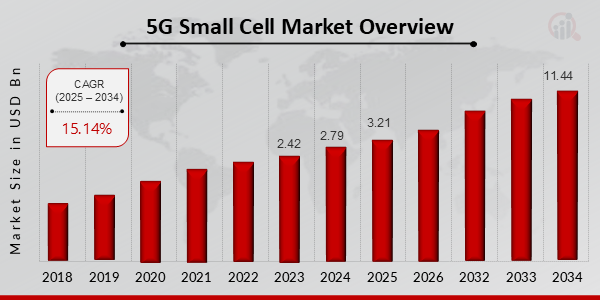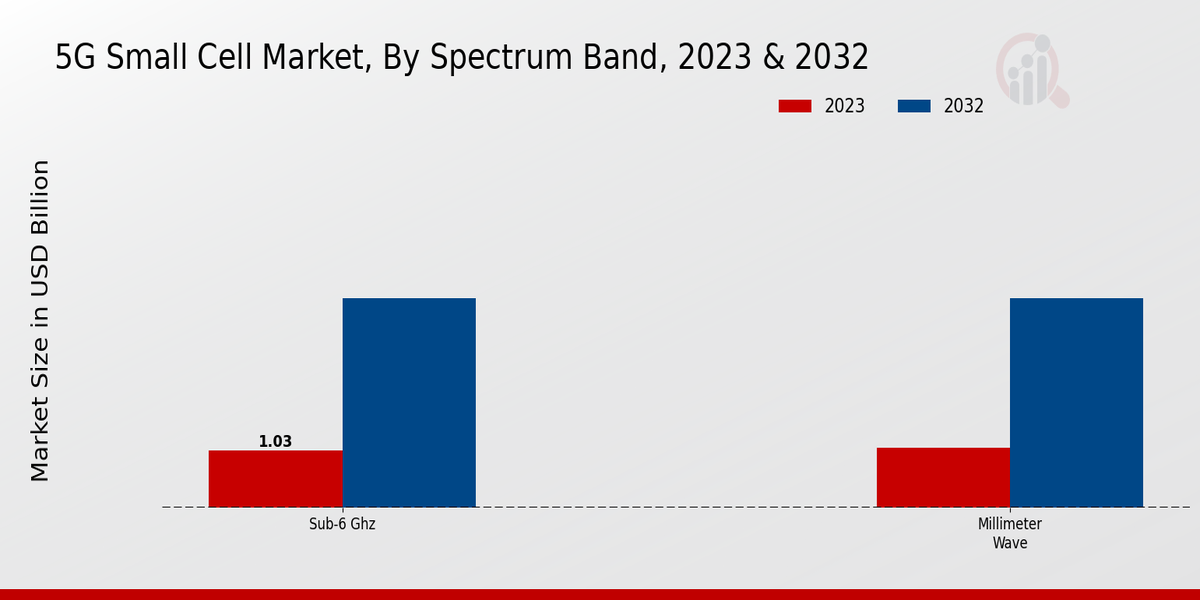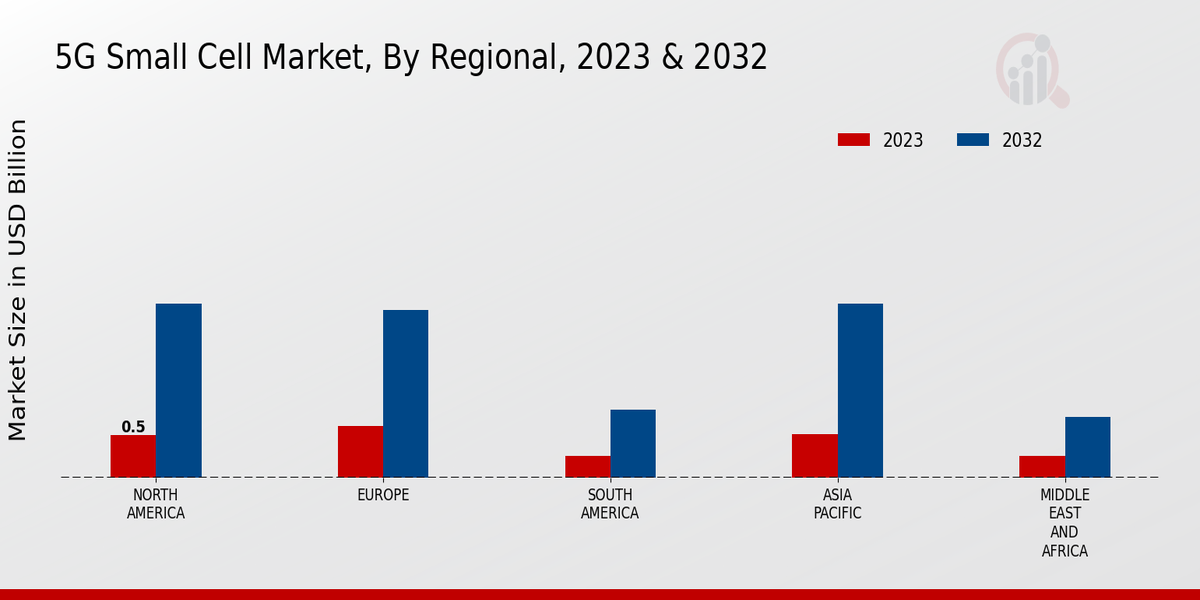5G Small Cell Market Overview
5G Small Cell Market is projected to grow from USD 3.21 Billion in 2025 to USD 11.44 Billion by 2034, exhibiting a compound annual growth rate (CAGR) of 15.14% during the forecast period (2025 - 2034). Additionally, the market size for 5G Small Cell Market was valued at USD 2.79 billion in 2024.
Key 5G Small Cell Market Trends Highlighted
The 5G small cell market is expected to witness significant growth in the coming years. This Significant growth is expected in the 5G small cell market over the next few years. This growth is mainly due to the rising need for high-speed, dependable wireless connections. Recently, there has been a trend toward deploying small cells in different indoor and outdoor settings like stadiums, airports, and downtown areas.
In the future, this will continue as demand for better mobile broadband services increases. Furthermore, the increasing popularity of Mobile Edge Computing (MEC) coupled with the adoption of Internet of Things (IoT) devices is also escalating the 5G small cell market to greater heights. These are some of the possibilities that businesses can explore and capture in this industry. Key drivers include increased demand for high speed, reliable wireless connectivity, growing use of IoT devices, and preference for mobile edge computing technology.
Figure 1: 5G Small Cell Market Size, 2025-2034 (USD Billion)

Source: Primary Research, Secondary Research, MRFR Database and Analyst Review
5G Small Cell Market Drivers
Increased Demand for High-Speed Connectivity
Various factors are fueling the surging demand for high-speed internet connectivity, one of which is the ever-rising number of bandwidth-intensive applications, such as video streaming, online gaming, and cloud-based services. All of these applications require a high level of bandwidth availability, which may be challenging to provide to users in highly urbanized areas using traditional cellular networks. Therefore, installing 5G small cells may help maintain an acceptable level of bandwidth and a strong signal that ensures uninterrupted high-speed access.
The increasing use of smartphones, laptops, and tablet PCs has also contributed to this growing demand.
Growing Adoption of IoT Devices
The other key driver for the growth of the 5G Small Cell Market Industry is the escalating Internet of Things ecosystem. IoT devices, such as sensors, smart home appliances, or industrial machinery, heavily rely on the provision of a reliable and low-latency connection to transmit vast amounts of data. 5G small cells can provide such connectivity, as they allow for high bandwidth, low latency, and better coverage. The demand for IoT devices has been on the rise in various industries, including healthcare, manufacturing, and transportation, ensuring the growth of the 5G small cell market in the years to come.
Government Initiatives and Spectrum Availability
Governments take several measures to promote the deployment of 5G small cells, which will enhance connectivity and innovation. They include favorable regulations, simplified permit issuance, and allocation of frequency using a tendering process aimed at encouraging carriers to invest in 5G infrastructure. For this reason, including millimeter wave spectrum and mid-band spectrum is crucial for the wide rollout of 5G small cells. On such grounds, governments are allocating and auctioning these frequencies to help network operators expand their 5G coverage and capacity.
5G Small Cell Market Segment Insights
5G Small Cell Market Spectrum Band Insights
The 5G Small Cell Market can be categorized by spectrum band into Sub-6 GHz and Millimeter Wave. The Sub-6 GHz band captured the largest share of the market in 2023, and it is expected to continue dominating the market through the forecast period. However, the Millimeter Wave band is forecasted to exhibit a higher CAGR over both the years owing to its ability to deliver higher bandwidth and lower latency. As such, while the Sub-6 GHz band is suitable for offering coverage in rural and suburban areas, where it can penetrate buildings and other obstacles better than the Millimeter Wave band, the former option can better serve dense urban areas.
The modest level of growth will be purposeful, driven by the increasing demand for 5G connectivity, the adoption of small cells, and the establishment of various governmental initiatives to enable and promote 5G deployment around the world. The major players in the 5G Small Cell Market include Ericsson, Nokia, Huawei, ZTE, and Samsung. These corporations demonstrate considerable investments in research and development, which is why new and revolutionary 5G small cell solutions are forecasted to become widespread.

Source: Primary Research, Secondary Research, MRFR Database and Analyst Review
5G Small Cell Market Deployment Insights
5G small cells can be applied across various deployment types, depending on specific needs and settings. Indoor deployment is suitable for enclosed spaces, such as office buildings, shopping centers, and stadiums, where serving capacity and coverage are most important. Outdoor application can be seen in public areas, urban settings, or street-level deployment. Remote/rural deployment is crucial for providing connection in hard-to-reach areas where no digital connectivity exists. For example, the recent 5G Small Cell Market by Component, Radio Technology and End-User Industry – Analysis and Forecast, 2032 Report says that the indoor deployment segment has dominated the industry in 2023 and is going to lead during the forecast period.
The primary cause is a significant demand for high-speed data services and drastic improvements to indoor coverage. Outdoor and remote/rural deployment are also vital segments and are expected to develop simultaneously, given the growing introduction of 5G in a variety of industries and the immediate need for improving connectivity in rural regions. Overall, the 5G Small Cell Market is expected to experience rapid development, driven by the increasing demand for mobile data and advances in 5G infrastructure.
5G Small Cell Market Antenna Polarization Insights
The Antenna Polarization segment of the 5G Small Cell Market is categorized into Vertical and Horizontal. Vertical polarization is anticipated to hold a larger market share over the forecast period due to its ability to provide better coverage and signal penetration in urban environments with high-rise buildings and dense populations. This polarization technique reduces interference and improves the signal-to-noise ratio, making it suitable for dense urban deployments. In contrast, Horizontal polarization is commonly used in rural areas with less dense populations and fewer obstacles, as it offers wider coverage but may experience signal degradation in urban canyons.
The 5G Small Cell Market revenue for Vertical polarization is projected to reach USD 3.1 billion by 2024, while the Horizontal polarization segment is estimated to generate USD 2.2 billion in the same year. The market growth for both segments is attributed to the increasing adoption of 5G technology and the rising demand for improved network capacity and coverage.
5G Small Cell Market Modulation Schemes Insights
The 5G Small Cell Market is segmented by modulation schemes into OFDM, OFDMA, and MU-MIMO. OFDM (Orthogonal Frequency Division Multiplexing) is a multicarrier modulation technique that divides the available spectrum into a large number of narrowband subcarriers. This allows for high data rates and spectral efficiency. OFDMA (Orthogonal Frequency Division Multiple Access) is a multiple access scheme that allows multiple users to share the same spectrum without interference. MU-MIMO (Multi-User Multiple-Input Multiple-Output) is a technology that allows a base station to transmit data to multiple users simultaneously using multiple antennas.
The OFDM segment is expected to account for the largest share of the 5G Small Cell Market revenue in 2024. OFDM is the most widely used modulation scheme in 5G small cells due to its high data rates and spectral efficiency. The OFDMA segment is expected to grow at a faster rate than the OFDM segment during the forecast period. OFDMA is a more efficient multiple access scheme than OFDM, and it is expected to be widely adopted in 5G small cells to support the increasing number of connected devices. The MU-MIMO segment is expected to account for a small share of the 5G Small Cell Market revenue in 2024.
MU-MIMO is a more complex technology than OFDM and OFDMA, and it is expected to be adopted in high-capacity 5G small cells.
5G Small Cell Market Product Type Insights
The 5G Small Cell Market is segmented by product type into pico cells, micro cells, and macro cells. Among these, the pico cell segment is expected to hold the largest market share of 42.5% in 2023, with a market value of USD 0.99 billion, owing to its wide range of applications in indoor and outdoor environments. The micro cell segment is projected to grow at the highest CAGR of 17.2% during the forecast period, reaching a market value of USD 1.87 billion by 2032, driven by its increasing adoption in urban areas and dense deployments. The macro cell segment is anticipated to account for a significant market share, with a market value of USD 2.83 billion by 2032, due to its ability to provide wider coverage and higher capacity in outdoor environments.
5G Small Cell Market Regional Insights
The 5G Small Cell Market revenue is expected to reach USD 7.5 billion by 2032, exhibiting a CAGR of 15.14% during the forecast period. Regionally, North America is expected to hold the largest market share, followed by Europe, APAC, South America, and MEA. The increasing demand for mobile broadband services, the growing adoption of 5G technology, and government initiatives to promote 5G infrastructure development are driving the market growth. Additionally, the rising number of connected devices and the need for improved network capacity and coverage are fueling the demand for 5G small cells.
APAC is expected to witness the highest growth rate during the forecast period due to the increasing adoption of 5G technology in countries such as China, India, and Japan. The rising demand for mobile broadband services and the growing number of connected devices are also contributing to the market growth in this region.

Source: Primary Research, Secondary Research, MRFR Database and Analyst Review
5G Small Cell Market Key Players And Competitive Insights
Major players in the 5G Small Cell Market are investing heavily in research and development to gain a competitive edge. The Leading 5G Small Cell Market players are focusing on developing innovative products and solutions to meet the growing demand for 5G connectivity. They are also expanding their geographical reach by entering new markets and forming strategic partnerships with local players. The 5G Small Cell Market industry is expected to witness significant growth in the coming years due to the increasing adoption of 5G technology and the expanding demand for high-speed wireless connectivity.
Nokia is a leading provider of 5G small cell solutions. The company offers a wide range of products and solutions that are designed to meet the needs of various operators and enterprises. Nokia's 5G small cell solutions are known for their high performance, reliability, and scalability. The company has a strong presence, and it is working with leading operators around the world to deploy 5G networks.
Ericsson is another major player in the 5G small cell market. The company offers a comprehensive portfolio of 5G small cell solutions that are designed to meet the needs of various operators and enterprises. Ericsson's 5G small cell solutions are known for their high performance, reliability, and scalability. The company has a strong presence, and it is working with leading operators around the world to deploy 5G networks.
Key Companies in the 5G Small Cell Market Include:
5G Small Cell Market Industry Developments
The 5G Small Cell Market is projected to reach a valuation of USD 7.5 billion by 2032, expanding at a CAGR of 15.14% from 2023 to 2032. Growing demand for enhanced mobile broadband services, increasing adoption of smartphones and tablets, and rising investments in smart city infrastructure are driving market growth.
Recent developments include the deployment of 5G small cells in rural and underserved areas to bridge the digital divide, the development of innovative small cell designs to improve coverage and capacity, and the integration of artificial intelligence (AI) and machine learning (ML) to optimize network performance. Key players in the market include Ericsson, Nokia, Huawei, and Qualcomm.
5G Small Cell Market Segmentation Insights
-
5G Small Cell Market Spectrum Band Outlook
-
Sub-6 GHz
-
Millimeter Wave
-
5G Small Cell Market Deployment Outlook
-
Indoor
-
Outdoor
-
Remote/Rural
-
5G Small Cell Market Antenna Polarization Outlook
-
Vertical
-
Horizontal
-
5G Small Cell Market Modulation Schemes Outlook
-
OFDM
-
OFDMA
-
MU-MIMO
-
5G Small Cell Market Product Type Outlook
-
Pico Cell
-
Micro Cell
-
Macro Cell
-
5G Small Cell Market Regional Outlook
-
North America
-
Europe
-
South America
-
Asia Pacific
-
Middle East and Africa
| Report Attribute/Metric |
Details |
|
Market Size 2024
|
2.79 (USD Billion)
|
|
Market Size 2025
|
3.21 (USD Billion)
|
|
Market Size 2034
|
11.44 (USD Billion)
|
|
Compound Annual Growth Rate (CAGR)
|
15.14% (2025 - 2034)
|
|
Report Coverage
|
Revenue Forecast, Competitive Landscape, Growth Factors, and Trends
|
|
Base Year
|
2024
|
|
Market Forecast Period
|
2025 - 2034
|
|
Historical Data
|
2019 - 2023
|
|
Market Forecast Units
|
USD Billion
|
| Key Companies Profiled |
CommScope, Nokia, Askey Computer, Cisco, Airspan Networks, Quectel Wireless Solutions, Ericsson, NEC, Samsung, Intel, Huawei, Fujitsu, Sercomm, Wistron, Qualcomm |
| Segments Covered |
Spectrum Band, Deployment, Antenna Polarization, Modulation Schemes, Product Type, Regional |
| Key Market Opportunities |
Enhanced mobile broadband eMBB ultralow latency ULL and massive machine type communications mMTCExpanding use of 5G in rural and remote areasIntegration of 5G with other technologies, such as IoT and cloud computingGovernment initiatives and regulations promoting 5G adoptionIncreased demand for highspeed and reliable internet connectivity |
| Key Market Dynamics |
Increasing demand for network capacityGrowing need for seamless connectivityRise of IoT and smart city applicationsGovernment support for 5G infrastructure developmentAdvancements in 5G technology |
| Countries Covered |
North America, Europe, APAC, South America, MEA |
Frequently Asked Questions (FAQ) :
The 5G Small Cell Market is projected to reach an overall valuation of 3.21 Billion USD in 2025.
The 5G Small Cell Market is anticipated to grow at a CAGR of 15.14% during the forecast period 2025 - 2034.
The 5G Small Cell Market is projected to reach an overall valuation of 11.44 Billion USD by 2034.
The Asia-Pacific region is anticipated to hold the largest market share in the 5G Small Cell Market due to the increasing adoption of 5G technology and the presence of a large number of mobile subscribers.
Some of the key competitors in the 5G Small Cell Market include Huawei, Ericsson, Nokia, Samsung, and Qualcomm.
5G Small Cells are primarily used to enhance network capacity and coverage in areas with high traffic demand, such as urban centers, stadiums, and enterprise campuses.
The growth of the 5G Small Cell Market is primarily driven by the increasing demand for high-speed data connectivity, the expansion of 5G networks, and the growing adoption of IoT devices.
The 5G Small Cell Market faces challenges such as high deployment costs, limited spectrum availability, and the need for standardization.
Opportunities for growth in the 5G Small Cell Market include the development of new applications, the expansion of 5G networks into rural areas, and the increasing adoption of 5G-enabled devices.
Key trends in the 5G Small Cell Market include the increasing adoption of Massive MIMO technology, the development of integrated small cells, and the growing use of artificial intelligence (AI) for network optimization.

















